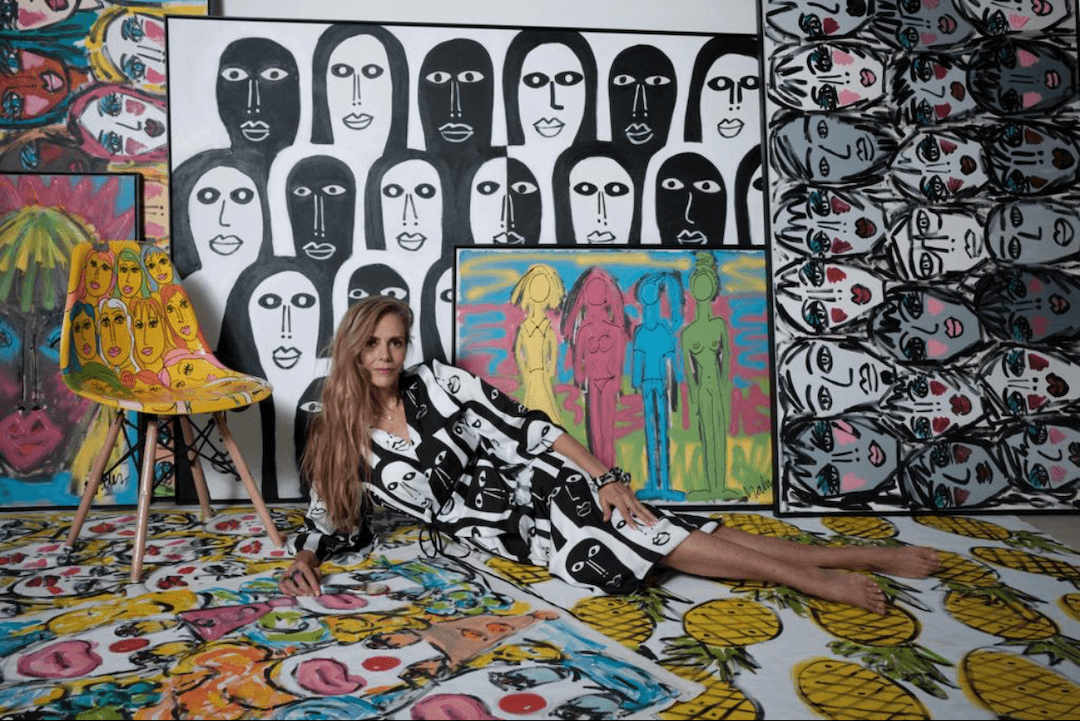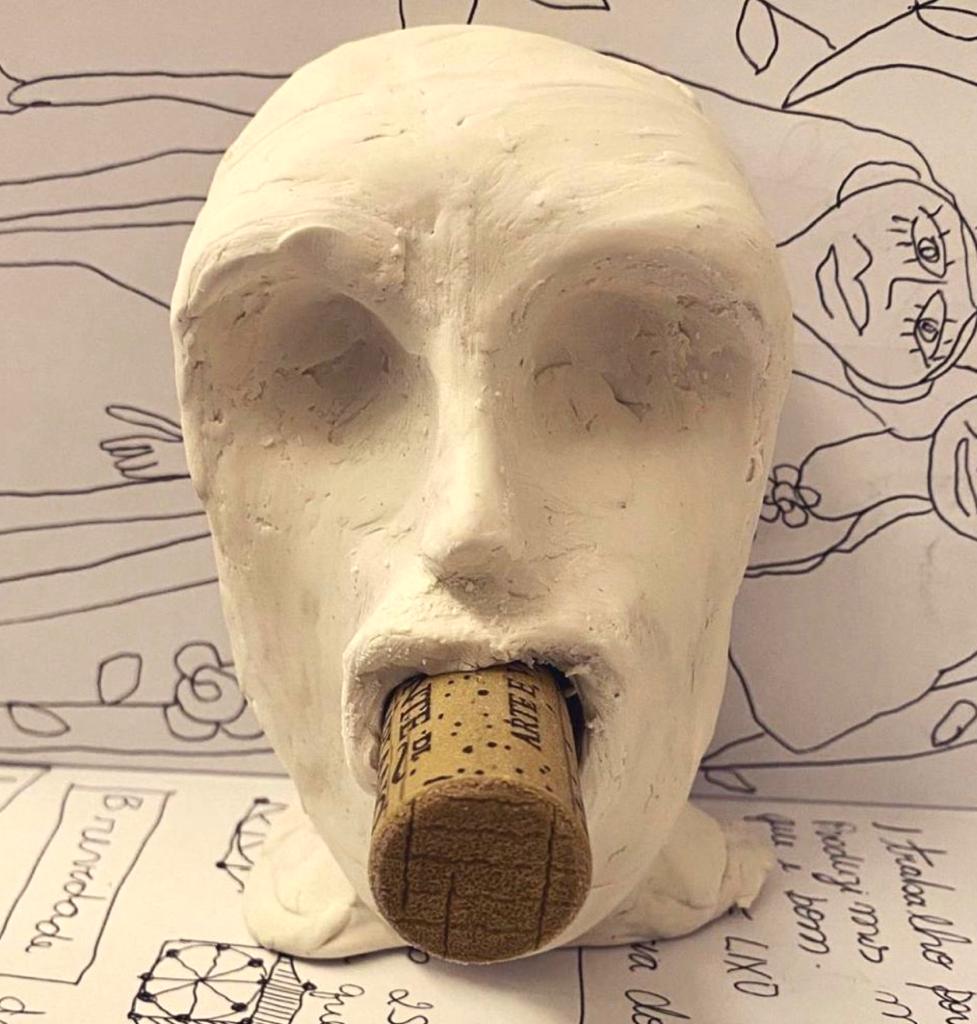
Biografia
Malu é publicitária, e tem formação artística pela The Art Students League of New York e pela The Art Studio NY.
Suas obras pretendem estender e questionar as fronteiras e origens do comportamento humano atual. Olhares, expressões, maquiagens, excessos, julgamentos, fama, fracasso, busca pela perfeição são temas abordados. A artista faz uma crítica caricata à futilidade humana na sua complexa dimensão. De maneira dialética, os trabalhos da artista englobam as polaridades “real x artificial” do comportamento humano moderno.

Malu Rogers: Posso Falar?
Claudia Calirman
Um rosto com a boca tampada por uma rolha é impedido de falar o que não deve ser dito. No título que acompanha a escultura de gesso, está a indagação: Posso Falar? Sem olhos, nem fala, esse é um rosto anônimo; apenas uma superfície com orifícios. Nesse rosto engessado, assim como em outras obras de Malu Rogers há uma inquietude sobre a imobilidade e o aprisionamento feminino dentro de normas sociais. Ao comentar sarcasticamente sobre a objetificação da mulher, Malu usa a iconografia do rosto de forma recorrente em seu trabalho, seja nas esculturas, desenhos, ou pinturas em tinta acrílica. À quem pertence essas caras e bocas? À que elas se referem? À que regras estão submetidas? Que mecanismos de poder as calam?
O que se vê são bocas e narizes de formatos similares, seguindo um padrão único de beleza. Essas figuras interrogam construções pré-estabelecidas sobre corpos fabricados e programados. Nesse universo, a beleza individual se dilui em um mundo mecanizado e padronizado onde preenchimentos de silicone, cirurgias plásticas e bocas botocadas impõem estereótipos femininos. Rostos feitos em série, como fantasmas de si mesmos, pura máquinas de sedução e desejo. Todos homogeneizados, se adequando aos mesmos códigos de beleza e conduta. São rostos descartáveis, com suas máscaras de artifício; manequins disponíveis e à venda em vitrines como mercadoria. Signos de consumo que seguem códigos prescritos do corpo feminino.
Essas figuras parecem simulacros saídos de uma única matriz que molda e programa rostos treinados para seduzir. Eles pertencem à um mecanismo de poder que promove a sedução das mulheres para atrair tanto a atenção masculina quanto a inveja feminina. Essas figuras não são apenas objetos de desejo dos homens; mas também são invejadas por outras mulheres que querem ser desejadas pelos homens. Ao expor estratégias femininas de sedução como ferramentas de poder e controle, esses rostos apontam para a tirania da beleza feminina idealizada. Como objetos de sedução, eles tanto podem atuar como ferramentas de libertação feminina, como podem ser usados como instrumentos de disciplina, criando uma ilusão de emancipação através de aparatos de subjugação.
Como na arte Pop, Malu usa cores fortes e eletrizantes para falar de um universo onde tudo é comércio, troca e sedução. Não só seus artifícios artísticos se referem a arte Pop no uso da serialidade, repetição, e mecanização, mas também na sua crítica ao mundo comercial. As figuras de Malu são um comentário irônico sobre a busca do embelezamento para o consumo, enfrentando a pressão para atender aos padrões e demandas convencionais de beleza feminina. Rostos alegres, fruto de uma tristeza mascarada e maquiada que performam o feminino por meio de atos e gestos sedutores. Segundo Jean Baudrillard, “as mulheres não podem confiar razoavelmente nem no brilho de seus olhos, nem na suavidade de sua pele: essas coisas, que são suas, não lhes trazem nenhuma certeza. Há uma grande diferença entre ter valor próprio por força das qualidades naturais e mostrar-se da melhor maneira subscrevendo à um modelo e conformando-se à um código pré-fabricado.”¹
As figuras de Malu apontam para situações limite de aprisionamento feminino, ao mesmo tempo que questionam valores impostos por uma sociedade patriarcal. Essa ambiguidade se reflete nos títulos das obras: Procurando se encontrar, Patrulha, Na fila do espelho, Resgate, Contando até 10, Descartável e Do lar. Ao imaginar novos mundos possíveis, elas sonham em deixar para trás regulamentos estabelecidos que não as servem mais. Elas parecem acreditar na possibilidade de transformação da moral vigente.
O filósofo Peter Pal Pelbart nos diz que, “Quando um pensador sai de sua clandestinidade especulativa e se põe a falar, é preciso saber que sua voz soará mais rouca e cáustica do que em suas construções sistemáticas, mas também mais serena, mais trágica, mais alegre.”2 Ao buscar encontrar sua voz, essas figuras parecem querer resistir imposições normativas e se tornar agentes de mudança. De acordo com a escritora Tatiana Salem Levy, “Resistir é tornar-se estrangeiro, estranho na própria cultura, é devir-menor, tornar-se nômade, exilado, errante.” 3 Ao resistir à formas dispositivas de aprisionamento, através de suas figuras, Malu busca novas maneiras de existir, afirmando o desejo de criar a possibilidade de um mundo distante de certezas e verdades, um mundo onde tudo ainda está por vir.
_______________________
¹ BAUDRILLARD, Jean. The Consumer Society: Myths & Structures. Londres: Sage Publications, 1998, p. 96. Tradução da autora.
² PELBART, Peter Pal (Prefácio e tradução). Gilles Deleuze: Conversações: 1972-1990. São Paulo: editora 34, 1992.
³ LEVY, Tatiana Salem. A Experiência do Fora: Blanchot, Foucault e Deleuze. Rio de Janeiro: Civilizaçāo Brasileira, 2011, p. 137
Malu Rogers: May I speak?
Claudia Calirman
A face with its mouth sealed by a wine cork is prevented from speaking what should not be spoken. The title that accompanies the plaster sculpture poses the question: May I speak? With no eyes, or speech, this is an anonymous face—a surface with blank holes. In this plastered face, as in Malu Rogers’s other works, there is disconcert around the immobility and imprisonment of women within social norms. In her sarcastic commentary about the objectification of women, Malu uses the face as a recurring element in her work, whether in sculptures, drawings, or acrylic paintings. Who do these faces and mouths belong to? What are they trying to say? What rules govern them? What mechanisms of power silence them?
What is seen are noses and mouths of similar shape, following a single standard of beauty. These figures question pre-established constructions about fabricated and programmed bodies. In this universe, individual beauty is diluted within a mechanized and standardized world, where silicone, plastic surgeries, and botoxed lips impose a feminine stereotype. These mass produced faces, like ghosts of themselves, are machines built for seduction and desire. They are uniform, adhering to the same codes of beauty and conduct. These faces are disposable, masked; they are mannequins displayed and for sale like merchandise, objects of consumption following prescribed codes about the female body.
The figures appear like simulations built from a single matrix that shapes and programs them for seduction. They belong to a power mechanism that promotes female seduction to attract both masculine attention and feminine envy—they are objects of desire not just for men, but are also envied by other women who want to be desired by men. By exposing female strategies of seduction as tools of power and control, these faces also expose the tyranny of idealized feminine beauty. These seduction strategies can be tools of female liberation, but they can also be used as means of discipline, creating the illusion of emancipation through an apparatus of subjugation.
Using pop art as inspiration, Malu uses strong, electrifying colors to expose a universe where all is consumption, trade, and seduction. The references to pop art are found not just in her techniques, which incorporate repetition and mechanization, but also in her critique of the commercial. Malu’s figures are a sarcastic commentary about the search for beauty for consumption, which is characterized by societal pressures to comform to the conventional standards and demands of feminine beauty. The faces in her works appear happy as a result of masking and manicuring their unhappiness for the sake of performing femininity. According to Jean Baudrillard, “women cannot reasonably trust in the sparkle of their eyes, nor in the softness of their skin: these things they possess do not bring them any certainty. There is a difference between having inherent value by virtue of one’s natural qualities and displaying yourself in the best way by subscribing to a model and conforming to a fabricated code.”¹
Malu’s figures point to situations where female imprisonment has reached its peak, while also questioning the values imposed by a patriarchal society. These critiques are reflected in the title of her works: Looking to find oneself, Patrol, In line for the mirror, Rescue, Counting to ten, Disposable, and Of the home. Her figures imagine alternate worlds and dream of leaving behind established rules that do not serve them. They appear to believe in the possibility of transforming the morality that governs their society.
As the philosopher Peter Pal Pelbart observed, “When a thinker leaves his clandestine speculations and begins to speak, his voice will sound more hoarse and caustic than it did in his systematic constructions, but it will also be more serene, more tragic, happier.”2 In searching for their voices, Malu’s figures seem to want to resist normative impositions and become agents of change. As the writer Tatiana Salem Levy posed, “To resist is to become foreign, a stranger in one’s own culture, it is to become less than, a nomad, exiled, errant.”3 By resisting methods of imprisonment through her figures, Malu searches for new ways of existing, affirming the desire to create a world remote from certainties and truths, a world where everything is yet to come.
_______________________
¹ Baudrillard, Jean. The Consumer Society: Myths and Stuctures. London, 1998, p. 96. Unofficial translation.
² Pelbart, Peter Pal. Gilles Deleuze: Conversations: 1972-1990. Sao Paulo, 1992. Unofficial translation.
³ Levy, Tatiana Salem. A Experiencia do Fora: Blanchot, Foucault e Deleuze. Rio de Janeiro, 2011, p. 137. Unofficial translation